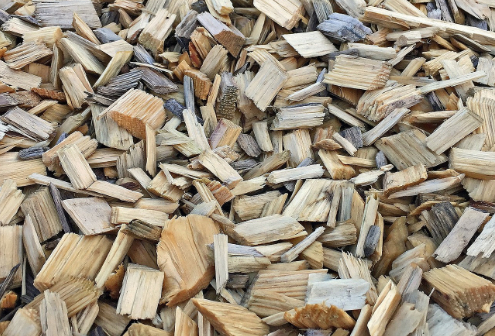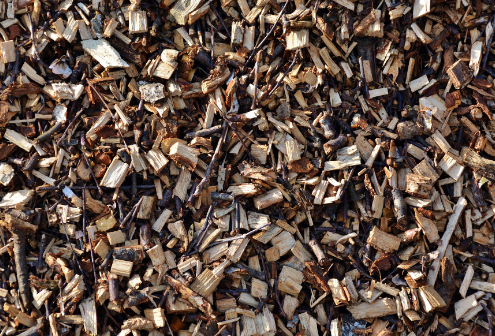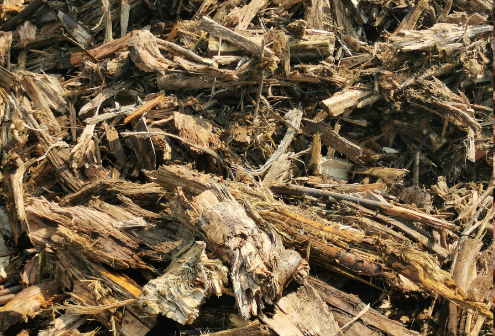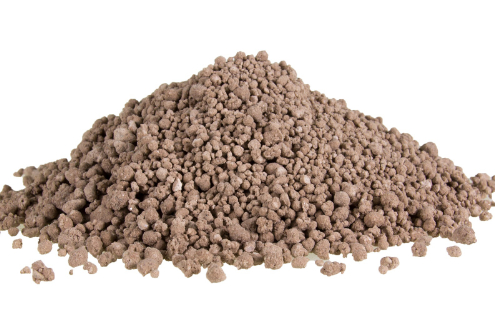Filling materials
Our filtering material: PURE BIO
Natural bioactive supports consist of materials that naturally contain bacteria dispersed in the structure of the medium itself, rather than as a distinct biofilm on the surface and within the pores. Some of the most common natural supports are: soil, compost, peat, various types of wood.
Most natural media contain organic matter; the adsorption of contaminants on these materials occurs through many physical-chemical processes, such as: van der Waals forces, H bonds, dipole-dipole interaction, ion exchange, covalent bond, ligand exchange, and / or hydrophobic partition.
The absorption / adsorption (sorption) of the contaminant can be schematized as a combination of two mechanisms: (1) hydrophobic partition from the aqueous phase (the contaminant is solubilized by the gas phase) and (2) adsorption on the surface of the medium (phenomenon that tends to dominate when contaminants are present at low concentrations).
Contaminants, once adsorbed in the organic fraction of natural supports, are subjected to a combination of abiotic transformations (such as hydrolysis, chemical bonding, red-ox reactions, polymerization) which are often catalysed by the metal oxides. Generally, biodegradation of pollutants can be obtained via aerobic and/or anaerobic processes, depending on microbial population (e.g., heterotrophic and autotrophic bacteria, actinomycetes, fungi and protozoa) which is stimulated.
Mass transfer of contaminants within the aggregates of the natural material affects the performance of the filter support and it is dependent on the humidity of the support (i.e., filtering material). Under a critical water content, the bioactivity of the medium is negligible and the medium loses its structure, creating cracks through which contaminated air can by-pass the bed. Experiments reported in scientific literature have shown that there is an “optimal” water content at which bioactivity is maximized; therefore, above and below this value the biodegradation rate begins to decrease, mainly due to the mass transfer constraints caused by the water film that forms (or disappears) outside the filling material. It is important to underline that the prolonged lack of water leads to the irreversible loss of the original bioactivity of the filter medium (each natural filtering material has a specific water retention capacity, function of intrinsic porosity, which in turn depends to the characteristics of the material used for).
Finally, natural media during their life are subject to breakage and compaction which, if not properly managed, lead to channelling and to pressure drops in the filter bed.
In the light of what it has been briefly explained, it is clear that the identification of the appropriate filtering material and its correct management and maintenance (fare link al care plan) are fundamental elements for obtaining the desired removal yields. Arte e Lavoro, based on you needs, can realize the appropriate filtering material; our flagship filtering material is the so-called PURE BIO.
PURE BIO is a filtering material obtained from the mixing of woods (not composted, composted or mixed together) able to guarantee the optimal environmental conditions for the proliferation of the microbial population necessary to obtain an effective bio-removal process.
The materials used for obtaining the filtering mixture derive from the activities of mowing and pruning of the plants. The production cycle changes according to the characteristics required for the filtering material (characteristics are defined by our technicians); generally, woods essences are selected, screened and reduced in size (if required screened again).
For more information download PURE BIO’s data sheet (fare link).
Features
The main characteristics of PURE BIO are:
- high content of autochthonous microorganisms (such as, for example, actinomycetes, megaterium, licheniformis, subtilis, yeasts and enzymes)
- high porosity
- high content of macro and micro nutrients
- reduced pressure drops
- high removal yield for a wide range of pollutants (also without inoculation).
Thanks to these characteristics, PURE BIO can be effectively used for the removal of a wide spectrum of contaminants (such as, for example, odours, VOCs, NH3, H2S, mercaptans). Furthermore, the high content of macro and micro nutrients allows PURE BIO to manage any shocks due to sudden fluctuations in the feeding pollutants load.
ENVIRONMENTAL FEATURES – the virtuous cycle of PURE BIO
An important environmental aspect associated with the use of PURE BIO is what we like to call the “virtuous cycle” of the filtering material. This definition derives from the fact that, with rare exceptions, our filter material can be considered a green material because it is able to comply with all the most recent regulatory indications on waste management and circular economy.
Why do we speak about a “virtuous cycle”? The virtuous cycle starts at the origin of the process: basically, most of the woods used for the preparation of PURE BIO derive from the activities of mowing and pruning of the plants and not from deforestation activities. This allows to keep national forest resources unaltered and to limit CO2 emissions due to their cutting and transporting. Green waste, which are normally treated in composting plants, are used for the preparation of our filtering material. For the production, the green wastes are reduced in size and screened (according with our requirements) and then transported to the plants, i.e., the plants where the biofilters are in operation. Once the filtering material has ended its service life, it is delivered to the same plants from which they were originated, where it is recovered by means of composting at the end of which it is reintroduced into the environment as compost or filtering material. As you can see, the life cycle of PURE BIO is a closed (virtuous) cycle.
Other kinds of available filtering materials
- zeolites
- chestnut wood (available in different sizes)
- peat
- bark (available in different sizes)
- roots
- heather
- wood chip
- granular activated carbon (GAC)
Applications
PURE BIO is used in biofilters that treat contaminated air produced in solid/liquid waste treatment plants or wastewater treatment plants (such as, for example, incinerators).
For more information download PURE BIO’s data sheet (fare link).
ZEOLITES
Zeolites are microporous, aluminosilicate minerals commonly used as adsorbents and catalysts. They are tetrahedral, three dimensional, crystalline minerals of aluminosilicate earth metals. Zeolites have a porous structure that can accommodate a wide variety of cations, such as Na+, K+, Ca2+, Mg2+ and others. These positive ions are rather loosely held and can readily be exchanged for others in a contact solution. Zeolites occur naturally but are also produced industrially on a large scale.
Zeolites supplied by Arte e Lavoro are characterized by a high selective and cationic exchange power and can be used for:
- neutralization of harmful elements as heavy metals or organic molecules
- odorous removal
- absorption of inorganic (e.g., ammonia or hydrogen sulphide) and organic compounds (e.g., mercaptans)
- wastewater treatment and phytodepuration.
Based on material grain size, zeolites have a density between 750 to 1,000 kg/m3.
Thanks to our partnerships with qualified manufacturer and to the experience acquired in the odour removal, technicians refer to A&L Engineering can select the filtering materials that best meets your needs. Contact us for more info.
CHESTNUT WOOD (available in different sizes)
Chestnut wood is obtained from arboriculture and forestry. After an accurate screening process (for stones, soil and bark elimination), chestnut wood is submitted to a shredding process. The material deriving from these processes is available in different sizes (generally, from 25 to 130 mm) and a moisture content ranging from 40 to 50%. Based on material sizes, bulk density ranging from 250 to 350 kg/mg3 stereo. The ashes’ content of filtering material is less than 2%.
Thanks to our partnerships with qualified manufacturer and to the experience acquired in the odour removal, technicians refer to A&L Engineering can select the filtering materials that best meets your needs. Contact us for more info.
BARK (available in different sizes)
Normally, bark is defined as the outermost layers of stems and roots of woody plants. This definition is incorrect from a scientific point of view; in fact, in botanic bark is defined as an external parenchyma tissue, placed immediately under the epidermis in the primary structure of the stem and under the rizoderma in the primary structure of the root. In both cases, bark can be defined as the interface between the tree and the environment; its aim is protecting plant from parasites, disease and predators, as well as preventing liquids loss.
In air treatment field, generally, are used pine bark, spruce bark, larch bark, Douglas spruce bark. The bark’s pieces have a size ranging from 5 and 35 cm.
Thanks to our partnerships with qualified manufacturer and to the experience acquired in the odour removal, technicians refer to A&L Engineering can select the filtering materials that best meets your needs. Contact us for more info.
ROOTS
This filter material is obtained from the mechanical processing (e.g., shredding and screening) of selected stumps and roots, especially those of conifers and broad-leaved trees. In air treatment field roots are used in those cases (but not only) where it is mandatory guarantee a “long” service life of the filtering bed. Over the specific woods’ characteristics, long service life is due to the larger dimensions of the material; in fact, the size of material placed within the biofilters generally range from 12 and 80 cm. The larger the wood’s size the smaller is the degradation over the time and, consequently, pressure drops within the bed.
Thanks to our partnerships with qualified manufacturer and to the experience acquired in the odour removal, technicians refer to A&L Engineering can select the filtering materials that best meets your needs. Contact us for more info.
WOOD CHIPS
Product is realized mixing different wood essences such as chestnut, oak, beech wood and hardwood deriving from arboriculture and forestry activities. After an accurate screening process (for stones, soil and bark elimination), woods are submitted to a chipper. By means of this process, woods can be obtained in different sizes, ranging from 2 to 10 cm. Moisture content ranging from 40 to 50%.
Based on material sizes, bulk density ranging from 150 to 450 kg/mg3 stereo. The ashes’ content of filtering material is less than 2%.
Thanks to our partnerships with qualified manufacturer and to the experience acquired in the odour removal, technicians refer to A&L Engineering can select the filtering materials that best meets your needs. Contact us for more info.
PEAT
Peat is an accumulation of partially decayed vegetation or organic matter. Peat is formed in waterlogged soils with little or no access to oxygen (anaerobic conditions), largely preventing the complete decomposition of organic material. Over time, the formation of peat is often the first step in the geological formation of fossil fuels such as coal, particularly low-grade coal such as lignite.
Peat deposits are located in many places around the world, including Island, Russia, Ireland, Finland, Estonia, Scotland, Poland, Northern Germany and the Netherlands.
Peat can be classified on the basis of the following criteria:
- conditions under which the decomposition of the organic material took place: low and high peats;
- parcels size: small (< 0,84 mm), medium (0,84 – 2,38 mm) and large (> 2,38 mm);
- botanic composition: peat moss, plant-based peat;
- Von Post scale. In this case, peats are classified according to a “H” index, ranging from 1 (“young” peat, less decomposed) and 10 (“old” peat, very decomposed. Ancient peats are more compact, heavy and less porous;
- nutritional status: oligotrophic peats (low nutrients content), mesotrophic and eutrophic (high nutrients content).
Thanks to our partnerships with qualified manufacturer and to the experience acquired in the odour removal, technicians refer to A&L Engineering can select the filtering materials that best meets your needs. Contact us for more info.
GRANULAR ACTIVATED CARBONS (GAC)
Activated carbons are filtering materials that can be obtained by any organic material with a high carbon content, such as coconuts, coal, peat and wood, oil carbon. Raw material and the process used for the activation (i.e., chemical activation or gas activation) influence the pores distribution in the final product. Hence, activated carbons can be roughly classified as micro-porous or macro-porous. In any cases, activated carbons are produced specifically so as to achieve a very big internal surface (between 500 – 1500 m2/g). Due to this, active carbons are perfect for adsorption. Adsorption is the main process used by activated carbons for pollutant removal, although in some cases it is more appropriate using the term sorption (i.e., the combination of adsorption and absorption). Adsorption is a surface process that leads to transfer of a molecule from a fluid bulk to solid surface. This can occur because of physical forces (e.g., Van der Waals force) or by chemical bonds.
Activated carbons are available in two variations: Powder Activated Carbon (PAC) and Granular Activated Carbon (GAC). The GAC version is mostly used in air and water treatments.
Activated carbons can be used for odours and VOCs removal; although they are effective on a wide range of chemical compounds.
Thanks to our partnerships with qualified manufacturer and to the experience acquired in the odour removal, technicians refer to A&L Engineering can select the filtering materials that best meets your needs. Contact us for more info.










 @airqualitymaker.com
@airqualitymaker.com @airqualitymaker.com
@airqualitymaker.com